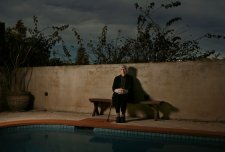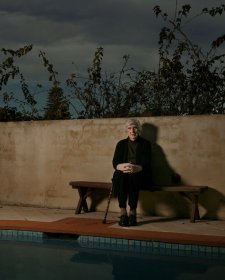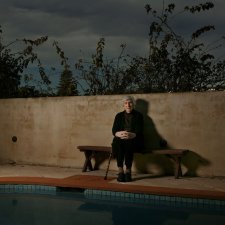- About us
- Support the Gallery
- Venue hire
- Publications
- Research library
- Organisation chart
- Employment
- Contact us
- Make a booking
- Onsite programs
- Online programs
- School visit information
- Learning resources
- Little Darlings
- Professional learning
Clifford Possum Tjapaltjarri AO (c. 1932–2002) was a founding member of the artists cooperative established at Papunya in the early 1970s and one of the most renowned practitioners within the Western Desert art movement. An Anmatyerr man, he was born on Napperby Station near Alice Springs and started his working life in the 1940s as a stockman. He worked at various stations throughout Central Australia, acquiring several languages and developing a profound knowledge of the Dreaming trails and sites around the McDonnell Ranges. He began carving during the same period and had established a reputation as a craftsman before becoming one of the first men to take up painting at Papunya, a settlement established 240 kilometres north-west of Alice Springs in the 1960s. What is now referred to as the Papunya movement began in 1971, when the men started transferring their designs from the body and the ground onto panels of masonite and other moveable surfaces. Papunya Tula Artists Ltd. was formed in 1972. Their works were mostly Tjukurrpa (Dreaming) stories, representing the creation of significant sites and landforms by ancestral beings along their paths of travel through traditional lands. Between 1976 and 1979, Tjapaltjarri created a series of large 'map paintings' in which he portrayed these trails as deeds of title to his ancestral land. These included a number of paintings depicting Warlugulong, the Bushfire Dreaming story relating to his mother's birthplace. In 1988, London’s Institute of Contemporary Art presented an exhibition of his paintings, and a second solo exhibition – also in London – in 1990 brought him critical acclaim in Europe and North America. Throughout the late 1980s and 1990s his paintings featured in numerous group shows and his works were acquired for collections in Australia and overseas. Toward the end of his life Tjapaltjarri was recognised as one of Australia's great painters, and in 2004, when the National Gallery of Victoria presented Clifford Possum Tjapaltjarri, he became the first of the Papunya Tula artists to have a retrospective exhibition at a major Australian art museum.
Tim Johnson became interested in the Papunya Tula Artists after seeing an exhibition of their paintings in Sydney in 1977. In 1980 he began visiting the Papunya settlement and came to know Clifford Possum Tjapaltjarri, Tim Leura Tjapaltjarri, Michael Nelson Jagamara and others, who invited him to paint with them. This heightened his appreciation of the idea that a painting might function as a map, and as a unified embodiment of place, identity and spirituality. As an artist who frequently incorporates celestial-like symbols and motifs in his work, Johnson was drawn to the meditative and intricate quality of dotting and sought permission from the Papunya artists to employ it. His friendships and collaborations with Tjapaltjarri and other artists helped Johnson 'see the surface of a painting like a field representing the entire universe.' Consequently, Johnson's portrait of Tjapaltjarri includes symbols, objects and vignettes from Tjapaltjarri's life in a composition that evokes the sitter's presence and biography as well as his inner world and a deep cultural knowledge unconstrained by time.
Commissioned with funds from the Basil Bressler Bequest 2002
© Tim Johnson
Basil P. Bressler (44 portraits supported)



On one level The Companion talks about the most famous and frontline Australians, but on another it tells us about ourselves.



Open Air is an exhibition of portraits of Australians in environments of particular significance to them.



The exhibition will include works of art from the NPG Canberra's permanent collection with some inward loans and aims to highlight the achievements of notable Australians.